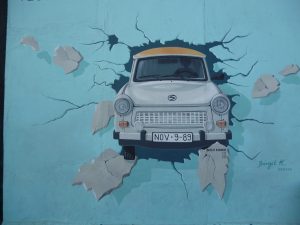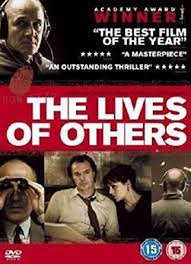What has happened to the GDR (German Democratic Republic), the country which was created when the Berlin wall went up and then disappeared when it came down? It was home to 17 million people for 28 years, between August 1961 and November 1989. What was life in East Berlin like in those days? And where in today’s Berlin can you find out all about it? This post suggests three Berlin museums where you can go in search of long-lost East Berlin.
The DDR Museum

The DDR Museum’s guidebook states its mission: to explain all about ‘daily life in a long- gone state’ and it makes for a fascinating visit. It’s full of documents, photos and realia, has recreations of a typical DDR home: a flat in a high-rise block, functional and, in true socialist style, deliberately just like every other flat in the building, with the same dimensions, layout and 70s-era brown and orange furniture
You will learn about shortages, a key feature of life in the planned economy that was the GDR. As people quipped at the time, ‘everything is available, just not all at once and not everywhere and especially not when you need it.’ People always carried a folding shopping bag, so that when goods did reappear they would be able to buy them straightaway before they ran out again. There was a wait of years to be allowed to buy a car, usually a Trabi – you can sit in one in the museum – and although they are a fondly remembered GDR symbol, they were not reliable. A joke from the time asked what you call a Trabi on a mountain. Answer: a miracle!

The displays on education stress the socialist approach: nurseries for every child so mothers could work, a school – and even university – curriculum which included the learning and regular testing of propaganda slogans, along with lots of sport and military training. Standards were high, producing ‘successful athletes, good soldiers, diligent engineers and qualified scientists’ but ‘critical thinking was unwanted.’ For adults, there was full employment, often in firms which had a creche, social and medical facilities, and also a ‘Wall of Fame’ rewards system for those who surpassed their allotted production quota.
The more sinister aspects of GDR living are covered too. This was a society in which everyone could expect to have their mail checked, along with their financial and medical records, and very possibly to have their telephones and homes bugged by the Stasi, the state police. By 1989, the Stasi had 93,000 official employees and some 173.000 informers.
The Stasi Museum
The Stasi Museum, housed in the former Stasi HQ in Normanenstrasse, is the place to discover the all-encroaching ways of the GDR’s state police in more detail. The motto, quoted in the guidebook, says it all: ‘Feind ist, wer anders denkt’, in English, ‘the enemy is anyone who thinks differently’. And the Stasi were everywhere, searching for those who did not support the regime in every detail of their lives. Here again, you can study documents and see such relics from the time as fake wigs and moustaches used for disguise and pens or handbags with hidden microphones, used by the Stasi when mixing in public, hoping to catch incriminating remarks. You can visit the office of Erich Mielke, Head of the Stasi from 1952 until its demise in 1989.

You can learn about the system of ‘smell samples’, collected from clothing taken in a break-in to a suspect’s flat, or by placing a piece of cloth on the chair of someone brought in for questioning, then labelled and stored in a glass jar for use by sniffer dogs in future operations. There is information too about the endless files kept on citizens – their movements on a night out, comments from family or work colleagues who were informers – to be used as evidence against them. After the fall of the wall, people were allowed access to their files and Anna Funder, author of Stasiland, writes about watching people reading them and wonders what mysteries were solved: ‘Why they didn’t get into university or couldn’t find a job, or which friend told Them about the forbidden Solzhenitsyn in their bookcase’. And yes, she wrote ‘Them’ with a capital T.
Hohenschönhausen

This sinister building, once Berlin’s Stasi Prison, is now a museum and memorial site. You can see information displays and films and tour the building, sometimes in the company of an ex-prisoner as a guide. The impact is huge: cells, interrogation rooms, descriptions of violence and other interrogation techniques used to break a prisoner’s resistance and will. From arrival, blindfolded in a van, prisoners were kept away from others, not even told where they were, and questioned relentlessly until they broke. The film ‘The Lives of Others’ includes scenes which were filmed here. If you have seen it, you will recognise the long, eerie corridors where the sound of approaching footsteps brought terror.
Listen to the podcast
Further Reading
Stasiland by Anna Funder
A factual account, written after extensive interviews with former East Germans.
Red Love by Maxim Leo
A family history, giving, as one critic put it, ‘an unbearably poignant description of a world that no longer exists.’
The House by the Lake by Thomas Harding
A broader sweep of German history, the story of all the families who lived in a house on Lake Glienicke, during the 20th century. The house is situated between Berlin and Potsdam, so during the period of the Berlin Wall it was in East Germany.
Film Suggestions
Goodbye, Lenin
A relatively light-hearted portrayal of life in East Germany, good on the details of everyday life for an ordinary family.
The Lives of Others
A much harder-hitting tale of an East German couple whose every move is watched by the Stasi.
Links for this Post
DDR Museum
Stasi Museum
Hohenschönhausen
Last Updated on November 21, 2024 by Marian Jones







